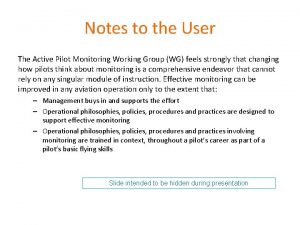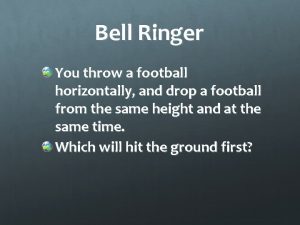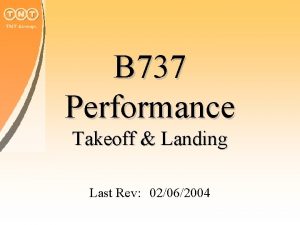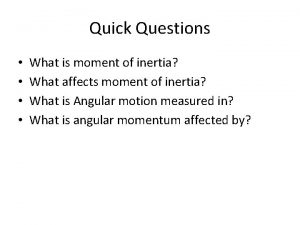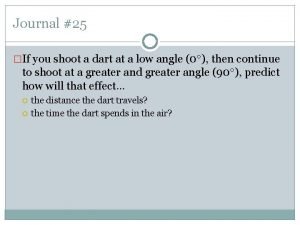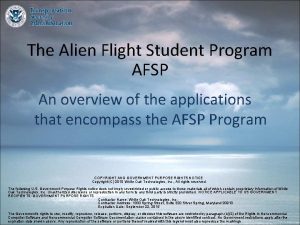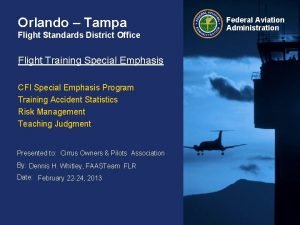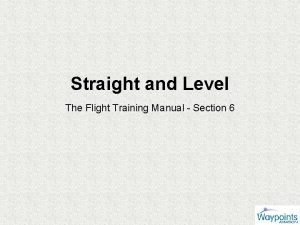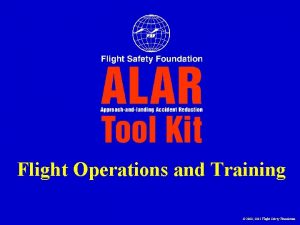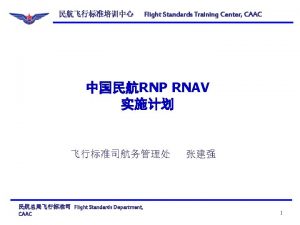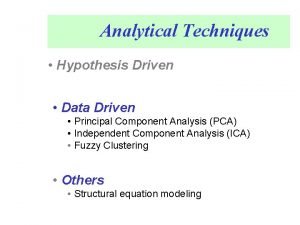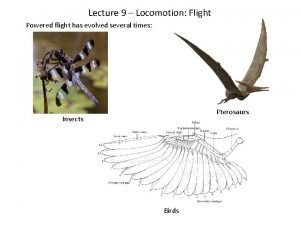Training Effective Flight Path Monitoring A data driven





















- Slides: 21

Training Effective Flight Path Monitoring A data driven approach Chris Ranganathan November 2018

Contents ▸ Using Data to quantify the problem ▸ LOSA Data ▸ Training Data ▸ Line Data ▸ Training Response ▸ Next steps 2

Context • A 320/A 330/A 380/B 787/B 777 • ~ 2100 pilots ~ 200 pilot instructors • All types in EBT since October 2015

Operations Data– LOSA 2015 LOSA Report: LOSA Raw Data 270 observations (narratives) 1673 Threats (avg: 6. 19 per flight) 2176 Errors (avg: 8. 05 per flight) 1. Identified and ranked Threats & Errors observed 2. Compared Crew Management of Threats, Errors against LOSA database average and against 4 peer airlines. 3. Rated crew performance in 11 Threat and Error Management countermeasures, on a 4 point scale

Correlating LOSA and EBT data (1/2) The 11 LOSA Countermeasures were related to one or more of the 9 Pilot Competencies by a comparison of the LOSA Behavioral Markers to Etihad Performance Indicators 5

Correlating LOSA and EBT data (2/2) Next step was to research industry papers/studies in the areas of Monitor/Cross Check and Workload Management Resulting Competencies of Focus: ▸ Application of Procedures (APK) ▸ Aircraft Flight Path Management, Automation (FPA) ▸ Aircraft Flight Path Management, Manual (FPM) ▸ Workload Management (WLM) ▸ Situation Awareness (SAW) Monitor / Cross Check related to 4 different competencies Workload Management was related to 3 of the top 5 negative net LOSA countermeasure rankings 6

Industry papers review Discovering and correcting flight path management errors: “ Effective Flight Path Monitoring”, or EFPM. Performance Indicators relevant to EFPM were identified based on industry research and refined during instructor workshops How frequently were these indicators cited as a cause of poor pilot performance in training/checking………. 7

EBT simulator data of pilot performance (all ranks) 8

PI data for grades <3 (all fleets: EVAL-SBT) 9

Line Check data of pilot performance Check to see if these issues identified in training/checking were contributing to incidents in unsupervised line operations………. 10

Correlation with Etihad Operational Data Most significant Tier 3 Safety Performance Indicators contributing to OVERALL AIRLINE Operational Risk ▸ Aircraft speed exceedance ▸ Level Bust induced by EY ▸ Aircraft speed exceedances ▸ Long landing Circa March 2018

Resulting Agreed Actions 1. Review and modify current competency framework to explicitly define Performance Indicators (PIs) relevant to EFPM 2. Review and modify initial and recurrent training programs to emphasize Areas of Vulnerability (Ao. Vs) - target the PIs relevant to EFPM 3. Train pilots to deliver Threat Based interactive briefings that emphasize the importance of the PM role 4. Implement a deliberate and comprehensive approach to training manual flying skills for Instructors & line pilots that raises self confidence 5. Ensure that instructors and evaluators: • Train the relevant performance indicators that reinforce the responsibility of the PM to challenge deviations; • Are proficient at training and evaluating competencies & performance indicators relevant to EFPM; and • Place emphasis on EFPM during line checks 12

Review and modify current competency framework to explicitly define Performance Indicators (PIs) relevant to EFPM Competency EY Performance Indicators for EFPM Application of Procedures (APK) Communication (COM) Monitors aircraft system status according to published operating instructions Flight Path Management Automation (FPA) Uses appropriate escalation of communication to resolve deviations identified by monitoring Monitors and Detects deviations from the desired aircraft trajectory and takes appropriate action Maintains the desired flight path during flight whilst monitoring and managing other tasks and distractions Flight Path Management Manual (FPM) Knowledge (KNO) Leadership and Teamwork (LTW) Confidently says and does what is important for safety, resolving deviations identified whilst monitoring using an escalation of communication Problem Solving & Decision Making (PSD) Monitors execution of decisions, reviews and adapts them as required Situation Awareness (SAW) Monitors, identifies and assesses Is aware of the state of the aircraft and its systems Monitors, identifies and assesses Is aware of where the aircraft is and its environment Workload Management (WLM) Monitors, Reviews, monitors and cross-checks actions conscientiously 13

Review and modify initial and recurrent training programs to emphasize Ao. Vs and target the PIs relevant to EFPM • Initial Training (thus far) • MPL • Boeing Type Rating curricula • Recurrent Training Medium/Method • Instructor led Ground Training • e-learning module • Initial Simulator Training: • Scenario Based Training • Recurrent Simulator Training: • EVAL, SBT and ISI phases of EBT


Training Appropriate Assertiveness in ISI Competency Communication (COM) Leadership and Teamwork (LTW) EY Performance Indicators for EFPM Uses appropriate escalation of communication to resolve deviations identified by monitoring Confidently says and does what is important for safety, resolving deviations identified whilst monitoring, using an escalation of communication 16

Training Monitoring in SBT & EVAL Competency (APK) (COM) (FPA)/ (FPM) (LTW) (SAW) (WLM) EY Performance Indicators for EFPM Follows SOP’s unless a higher degree of safety dictates otherwise Monitors aircraft system status according to published operating instructions Confirms that the recipient correctly understands important information Conveys messages and information clearly, accurately, timely and adequately Detects deviations from the desired aircraft trajectory and takes appropriate action Effectively monitors automation, including engagement and automatic mode transitions Maintains the desired flight path during flight whilst managing other tasks and distractions Selects appropriate level/mode of automation in a timely manner considering phase of flight & workload Anticipates other crew members’ needs and carries out instructions when directed Is aware of where the aircraft is and its environment Is aware of the state of the aircraft and it systems Ensures tasks are completed Manages interruptions, distractions, variations and failures effectively Offers and accepts assistance, delegates when necessary and asks for help early Plans, Prepares, prioritizes and schedules tasks effectively Reviews, monitors and cross-checks actions conscientiously • Changes in atmospheric conditions affecting aircraft energy Sim ula • Systems failures which are not declared by the internal warning systems tio n c • Failure to Capture Altitude, LOC, GS, NAV ha llen • Erroneous G/S ges …. • Erroneous LOC capture • False G/S • Thrust Management Computer improper thrust settings. Does not respond to thrust targets, no failure indication. 17

On a line flight – what does good EFPM look like? In Flight Phase During Cruise When interrupted by unanticipated tasks (WLM) Plans, Prepares, prioritizes and schedules tasks effectively Pilot Flying (PF) (COM) Confirms that the recipient correctly understands important • Use this time to anticipate and complete all tasks information (e. g. administrative tasks, stowing and pulling items, setting up and briefing approaches). (WLM) Offers and accepts assistance, delegates when necessary and asks for (FPA/FPM) Effectively monitors • Verbalize constraints/next action as needed to reinforce team awareness. (FPA/FPM) Maintains the desired flight help early automation/flight guidance, including path during flight using automation / engagement and automatic mode during manual flight whilst managing transitions • Perform task after checking PF is monitoring the other tasks and distractions • Delegate task to PM (or transfer aircraft control). • Continue monitoring flight path with high scan rate. When interrupted by non-normal situations During non-routine high-workload situations (e. g. Go-Around…) Pilot Monitoring (PM) flight path. • If PF inappropriately engages in non-monitoring task, then monitor flight path with high scan rate. • Monitor flight path with high scan rate • Avoid initiating procedures until aircraft trajectory is safe (Golden Rules). • Maintain awareness of flight path until other crewmember is concentrating on monitoring it. • Focus on monitor flight path with high scan rate. • Maintain high SAW of aircraft energy to avoid altitude bust. • Use correct callouts in the correct sequence. • Prioritize tasks to ensure correct aircraft configuration change (L/G, flaps retraction on schedule, …) during dynamic maneuver. • Delay ATC readback as appropriate: Fly-Navigate THEN Communicate (SAW) Is aware of where the aircraft is and its environment

Placing emphasis on EFPM during line checks EFPM behaviours in “Line Pilot speak”=== ===== Related EFPM Performance Indicators

Placing emphasis on EFPM during line checks EFPM behaviours in “Line Pilot speak” ===== Related EFPM Performance Indicators

Enabling Effective Flight Path Monitoring – next steps • Ensure Operations Policy and Training programs encourage an “Active” PM role • Ensure Operations Policy and Training programs, enable the confidence and skills required to hand fly during line operations, when appropriate • Continue to correlate Operations and Training Data to measure effectiveness of training programs • • Next LOSA to use EBT competency framework Train Safety Investigators to use competency framework when describing/classifying pilot performance • Continue to promote a pilot mindset of “healthy suspicion”.
 Approach path monitor
Approach path monitor A practical guide for improving flight path monitoring
A practical guide for improving flight path monitoring Flight flight freeze fawn
Flight flight freeze fawn How far does a bullet travel
How far does a bullet travel Colour 02062004
Colour 02062004 Flight path angle
Flight path angle What is inertia
What is inertia The path followed by a projectile
The path followed by a projectile Hot path cold path
Hot path cold path Prinsip dasar analisis kualitas lingkungan
Prinsip dasar analisis kualitas lingkungan Alien flight student program
Alien flight student program South florida fsdo
South florida fsdo How to maintain straight and level flight
How to maintain straight and level flight Indicated altitude
Indicated altitude Flight school management platform
Flight school management platform Slipstream
Slipstream Api driven ddi
Api driven ddi Data driven instruction cycle
Data driven instruction cycle Des fleet operations
Des fleet operations Query driven approach in data warehouse
Query driven approach in data warehouse Dbedashboard
Dbedashboard Data driven web applications
Data driven web applications

